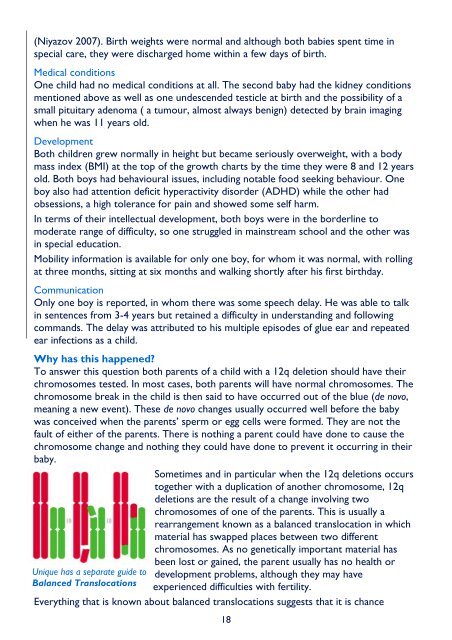12q deletion - Unique - The Rare Chromosome Disorder Support ...
12q deletion - Unique - The Rare Chromosome Disorder Support ...
12q deletion - Unique - The Rare Chromosome Disorder Support ...
Create successful ePaper yourself
Turn your PDF publications into a flip-book with our unique Google optimized e-Paper software.
(Niyazov 2007). Birth weights were normal and although both babies spent time in<br />
special care, they were discharged home within a few days of birth.<br />
Medical conditions<br />
One child had no medical conditions at all. <strong>The</strong> second baby had the kidney conditions<br />
mentioned above as well as one undescended testicle at birth and the possibility of a<br />
small pituitary adenoma ( a tumour, almost always benign) detected by brain imaging<br />
when he was 11 years old.<br />
Development<br />
Both children grew normally in height but became seriously overweight, with a body<br />
mass index (BMI) at the top of the growth charts by the time they were 8 and 12 years<br />
old. Both boys had behavioural issues, including notable food seeking behaviour. One<br />
boy also had attention deficit hyperactivity disorder (ADHD) while the other had<br />
obsessions, a high tolerance for pain and showed some self harm.<br />
In terms of their intellectual development, both boys were in the borderline to<br />
moderate range of difficulty, so one struggled in mainstream school and the other was<br />
in special education.<br />
Mobility information is available for only one boy, for whom it was normal, with rolling<br />
at three months, sitting at six months and walking shortly after his first birthday.<br />
Communication<br />
Only one boy is reported, in whom there was some speech delay. He was able to talk<br />
in sentences from 3-4 years but retained a difficulty in understanding and following<br />
commands. <strong>The</strong> delay was attributed to his multiple episodes of glue ear and repeated<br />
ear infections as a child.<br />
Why has this happened?<br />
To answer this question both parents of a child with a <strong>12q</strong> <strong>deletion</strong> should have their<br />
chromosomes tested. In most cases, both parents will have normal chromosomes. <strong>The</strong><br />
chromosome break in the child is then said to have occurred out of the blue (de novo,<br />
meaning a new event). <strong>The</strong>se de novo changes usually occurred well before the baby<br />
was conceived when the parents’ sperm or egg cells were formed. <strong>The</strong>y are not the<br />
fault of either of the parents. <strong>The</strong>re is nothing a parent could have done to cause the<br />
chromosome change and nothing they could have done to prevent it occurring in their<br />
baby.<br />
Sometimes and in particular when the <strong>12q</strong> <strong>deletion</strong>s occurs<br />
together with a duplication of another chromosome, <strong>12q</strong><br />
<strong>deletion</strong>s are the result of a change involving two<br />
chromosomes of one of the parents. This is usually a<br />
rearrangement known as a balanced translocation in which<br />
material has swapped places between two different<br />
chromosomes. As no genetically important material has<br />
been lost or gained, the parent usually has no health or<br />
<strong>Unique</strong> has a separate guide to development problems, although they may have<br />
Balanced Translocations experienced difficulties with fertility.<br />
Everything that is known about balanced translocations suggests that it is chance<br />
18
















